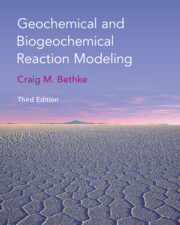Book contents
- Frontmatter
- Dedication
- Contents
- Preface
- Preface to Second Edition
- Preface to First Edition
- A Note About Software
- 1 Introduction
- 2 Modeling Overview
- PART I EQUILIBRIUM IN NATURAL WATERS
- 3 The Equilibrium State
- 4 Solving for the Equilibrium State
- 5 Changing the Basis
- 6 Equilibrium Models of NaturalWaters
- 7 Redox Disequilibrium
- 8 Activity Coefficients
- 9 Sorption and Ion Exchange
- 10 Surface Complexation
- 11 Three-Layer Complexation
- 12 Automatic Reaction Balancing
- 13 Uniqueness
- PART II REACTION PROCESSES
- PART III APPLIED REACTION MODELING
- Appendix A Sources of Modeling Software
- Appendix B Evaluating the HMW Activity Model
- Appendix C Minerals in the LLNL Database
- Appendix D Nonlinear Rate Laws
- References
- Index
10 - Surface Complexation
from PART I - EQUILIBRIUM IN NATURAL WATERS
Published online by Cambridge University Press: 09 December 2021
- Frontmatter
- Dedication
- Contents
- Preface
- Preface to Second Edition
- Preface to First Edition
- A Note About Software
- 1 Introduction
- 2 Modeling Overview
- PART I EQUILIBRIUM IN NATURAL WATERS
- 3 The Equilibrium State
- 4 Solving for the Equilibrium State
- 5 Changing the Basis
- 6 Equilibrium Models of NaturalWaters
- 7 Redox Disequilibrium
- 8 Activity Coefficients
- 9 Sorption and Ion Exchange
- 10 Surface Complexation
- 11 Three-Layer Complexation
- 12 Automatic Reaction Balancing
- 13 Uniqueness
- PART II REACTION PROCESSES
- PART III APPLIED REACTION MODELING
- Appendix A Sources of Modeling Software
- Appendix B Evaluating the HMW Activity Model
- Appendix C Minerals in the LLNL Database
- Appendix D Nonlinear Rate Laws
- References
- Index
Summary
Surface complexation is the process by which aqueous species react chemically with specific sites at the aqueous–solid interface to form surface complexes. This chapter describes in detail electrostatic double-layer theory and how it can be integrated into multicomponent equilibrium models. A worked example demonstrates how the theory might be applied in the study of natural waters.
Keywords
- Type
- Chapter
- Information
- Geochemical and Biogeochemical Reaction Modeling , pp. 131 - 146Publisher: Cambridge University PressPrint publication year: 2022

